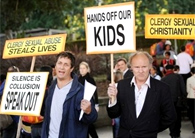The five-year study, which was commissioned by the US Conference of Catholic Bishops to provide a definitive answer to what caused the church’s sexual abuse crisis, has concluded that neither the all-male celibate priesthood nor homosexuality were to blame.
The study was unable to identify a single cause of the abuse and concluded that few of the abusive priests were paedophiles, as their victims were not all pre-pubescent. Less than 5% of the abusive priests could be defined as paedophiles because the majority of victims were aged between 11 and 14. But the finding was criticised by victims because the American Psychiatric Association defines paedophilia as an attraction to children aged 13 or younger, reports the UK Guardian. The authors said the majority of abusive priests were "generalists" – sex offenders who do not specialise in a type of victim by age or gender or other characteristics.

Initiated in 2006, the study is said to be the most authoritative analysis of the scandal in the Catholic Church in America. The New York Times reported that it was conducted by a team of researchers at the John Jay College of Criminal Justice in New York City at a cost of US$1.8 million, half of which was provided by the bishops, with additional money contributed by Catholic organisations and foundations. The National Institute of Justice, the research agency of the United States Department of Justice, supplied about US$280,000.
The report was released Wednesday by the United States Conference of Catholic Bishops in Washington, but the Religion News Service published an account of the report on its Web site on Tuesday.
The report stated:
Was celibacy to blame for the abuse? Gays in the priesthood? The social revolution of the ‘60s, or the benighted seminary education of the repressive 1950s?
The truth turns out to be far more complex, according to a copy of the report by researchers at John Jay College of Criminal Justice that was provided by a church leader who believes the findings accurately reflect the causes of the church’s sexual abuse crisis, for good and for ill.
The findings will likely unsettle both liberal and conservative critics, as well as victims’ advocates.
The 300-page report, formally called “The Causes and Context of Sexual Abuse of Minors by Catholic Priests in the United States, 1950-2010,” upends a number of popular misconceptions. While some will challenge the report’s methodology—and note that U.S. bishops paid for half the estimated $1.8 million price tag—the “Causes and Context” study is clearly a landmark in the research of child sexual abuse.
The first myth challenged by the study is that priests tend to be pedophiles. Of nearly 6,000 priests accused of abuse over the past half century (about 5 percent of the total number of priests serving during that period), less than 4 percent could be considered pedophiles, the report notes—that is, men who prey on children.
“Priest-abusers were not `pedophile priests’,” the researchers state flatly.
Second, the researchers found no statistical evidence that gay priests were more likely than straight priests to abuse minors—a finding that undermines a favorite talking point of many conservative Catholics. The disproportionate number of adolescent male victims was about opportunity, not preference or pathology, the report states.
What’s more, researchers note that the rise in the number of gay priests from the late 1970s onward actually corresponded with “a decreased incidence of abuse—not an increased incidence of abuse.”
Read the Religion News Service report.
Homosexual Behavior in United States Seminaries
Homosexual men entered the seminaries in noticeable numbers from the late 1970s through the 1980s. This statement is based on the direct experience and reports of seminary faculty and on many written reports by observers. It can be seen to have prompted the Letter on Priestly Formation by the Bishops of New England. What is not clear is whether the open expression of sexual identity in seminaries in this time period supports the thesis that more men were entering the seminary understanding themselves as homosexual—rather than being more likely to reveal themselves as homosexual—than in prior decades. Many ethnographic and journalistic reports by observers of Catholic seminary life in the mid-1970s and 1980s describe a situation that included much more open expression of homosexual identity, or what is called “homosexual lifestyle,” and some report homosexual behavior with adults as well. But any claim about the causal connection of the homosexual identification of late 1970s and 1980s seminarians to the likelihood of increased risk of engaging in child sexual abuse while in ministry would have to take into account the fundamental distribution of incidence. Men in the seminaries in the late 1970s and in the 1980s were members of cohorts that were identified with a decreased incidence of abuse—not an increased incidence of abuse. - Pg 38, The Causes and Context of Sexual Abuse of Minors by Catholic Priests in the United States, 1950-2010
From CNN's Belief Blog: Report on Catholic priests' sex abuse of minors finds no single cause:
The researchers found:
– Less than 5% of the priests who faced allegations were clinically diagnosed as pedophiles.
– Most priests who received treatment following allegations of abuse of a minor also reported sexual behavior with an adult.
– Researchers found no specific markers that would have been apparent across the board to disqualify candidates for the priesthood.
– Sexual orientation, specifically gayness, was not the cause of child sexual abuse by priests.
– The majority of abuse cases happened in the 1960s and 1970s and there was a sharp decline in the number of cases that began in the 1980s and continues today.
– Guidelines set up by the church to deal with the crisis when it came to light, including calling in civil authorities, were not adequately followed by most dioceses.
